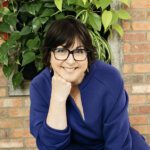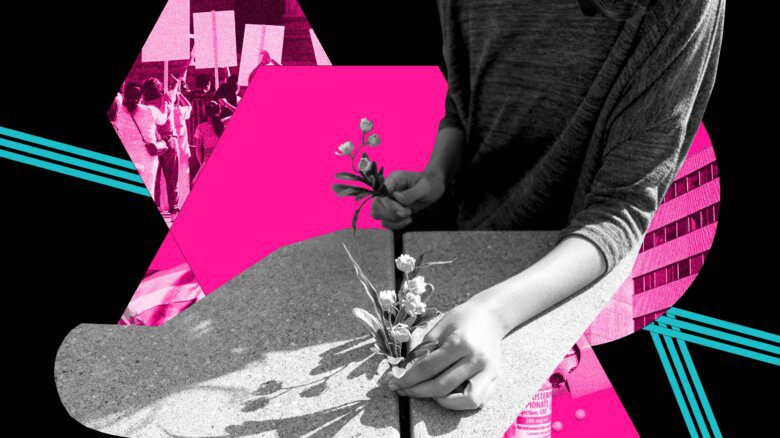In a nondescript one-storey building in the west end of Edmonton, you’ll find Action Potential Fitness, a small gym nestled in between a service dog training centre and a scrapbooking supplies shop. On the inside, it doesn’t look much different than any other fitness facility. Free weights and kettlebells, workout benches, a couple of squat racks and other manner of fitness equipment line the walls. Clients come and go on the hour, mingling with each other and the trainers before or after their individual sessions and group classes.
The uniqueness of this gym lies in the fact that over 70 percent of the staff, including the owners of the gym, identify as LGBTQ2S+. Look a bit closer and you’ll see a trans-flag-coloured stuffed shark mascot on a shelf overseeing one section of the gym, Progressive Pride flags and rainbows throughout the facility, non-gendered bathrooms and staff and clients who often wear pronoun pins or T-shirts.
Action Potential Fitness is where Toni Harris, co-owner and trans fitness trainer, finally had the opportunity to create and implement a project they’d been dreaming about for years: a fitness program designed for trans people, by trans fitness professionals.
Harris started to notice the need for more LGBTQ2S+-friendly fitness spaces in Edmonton after they graduated from their fitness-trainer program in 2017 and began working at a big box gym. One of the other trainers they worked alongside reached out to a local LGBTQ2S+ organization to recruit participants and start a group fitness class at the gym where they were working. But there was a catch: the owners of the facility would only allow the class to be scheduled 30 minutes after the gym closed and all of the other clients and trainers had left the building. It was then that Harris really began to understand the barriers and discrimination that the LGBTQ2S+ community face in the fitness world.
In the majority of fitness facilities, the gender binary is still very much entrenched. Policies such as gendered change rooms and classes, or requiring forms to be filled out with the name and gender on your ID create an exclusionary environment in which those who identify outside the binary are often forced to “choose a side.” This experience can make something as simple as exercising feel embarrassing and stressful.
“Gyms don’t even know how not inclusive they are,” says Zita Dube-Lockhart, Harris’s business partner and co-owner at Action Potential Fitness. Dube-Lockhart feels that one of the major limitations in the fitness industry is that it hasn’t done any real work to recruit, develop and train diverse people with different lived experiences. “The fitness world talks a big game about how we’re for everyone, but being for everyone means actually ensuring that you have everyone at the table in your leadership, in your instruction, in your conceptualization and in your participation. And actively looking for gaps in who you are not reaching.”
Back in 2017, Harris may have been somewhat heartened to see at least some space in the fitness world being carved out for LGBTQ2S+ people, but knew there had to be a better way to foster inclusion than relegating queer and trans clients to an after-hours slot. So they made it their personal and professional mission to better understand the fitness needs of the queer and trans community and to be part of building a space where those needs could be met.
Harris, who was not yet out as trans at the time, started researching exercise response and accessibility within the trans community, and began training more trans and non-binary clients one-on-one. They were slowly building a reputation as a safe and well-informed fitness professional within the local trans community in Edmonton. It was also through these interactions with trans clients that helped them build up the confidence to start their own transition. “The connections and relationships [I was building] with other trans humans and hearing their experiences made it less scary for me.”
Harris met Dube-Lockhart as they were both finishing the fitness-trainer program at the Northern Alberta Institute of Technology. They connected instantly and shared very similar views on fitness accessibility, body neutrality and inclusion. In April 2019, Harris moved their solo personal training practice to the gym space Dube-Lockhart was already running. When the pandemic struck, the two decided to weather the storm together. They formalized their partnership, rebranded the facility as Action Potential Fitness and worked relentlessly for two years to hold their community together.
“Their vision was to have a fitness space that was built on the framework of belonging, dignity and social justice.”
Their mission—fitness for every body and health for everyone—set the course of the facility and their niche quickly turned toward barrier reduction for marginalized populations. Dube-Lockhart says their vision was to have a fitness space that was built on the framework of “belonging, dignity and social justice.”
“We recognize that health is an individual and communal experience, mediated by issues of accessibility, social power and privilege,” says Dube-Lockhart, who is also queer and neurodivergent. “There are often difficulties in accessing the right information and professionals who understand and have similar lived experiences.” In order to address these challenges, and with the help of their mostly queer and neurodivergent staff, programs offered at Action Potential Fitness include ones for early learning and gross motor skill development for neurodiverse children and their parents/caregivers, youth programs and radical body acceptance fitness programs that are affirming and weight-neutral.
With the resources now in place in their own facility, Harris also began to develop programming to serve and support the trans community on a larger scale. In January 2023, the first cohort of trans and non-binary clients were enrolled in a free six-week “Intro to Weight Lifting” pilot program, called Fitness Trans Formed.
“We had put up a feeler post on social media, along with a registration link and thought we might get five or six people. We had 36 people register,” Harris says. They were elated and a bit overwhelmed with the response, but “just couldn’t turn anyone away.” Many of the fitness and wellness programs that were previously offered through other LGBTQ2S+ organizations in Edmonton had shut down during the pandemic and never restarted. “We heard from so many people who said they’d been waiting for something like this.”
Dorian Block was part of the inaugural group of Fitness Trans Formed participants. He had recently moved to Edmonton from the U.S. to be with his partner and was looking to find a community. His partner sent him an Instagram post about the program and he jumped at it and registered right away.
“I really started trying to masculinize my body in different ways when I started considering top surgery. I was not the physical type, and started with yoga stuff and then just weightlifting.” Block joined a gym when the date for his surgery was set. He was in Texas then, and he says walking into the gym was scary at times. “I felt like I was always putting myself in a space that wasn’t specifically built for me and always had to mentally pump myself up to go. I would say to myself, ‘You are paying to be here, you were here first for this piece of equipment.’” He was also very aware of how he dressed going to the gym, and before surgery, often wouldn’t use the men’s change room.
After surgery, Block was doing workouts he found online from trans creators posting on Instagram, but never anything that was tailored to him or his personal fitness goals. “Finding a trainer locally who shared an identity with me and was able to kind of match my fitness goals to my workouts, and my eating habits and dietary needs, was not something I ever thought possible.”
Block admits that being around other trans people had historically not been affirming for him. The pervasiveness of diet culture, shame and hyper-macho attitudes he had previously experienced left him with a lot of anxiety about even entering a space with other trans folks. One of the first things Block noticed when he joined the Fitness Trans Formed program was how body-neutral the environment was. “Everyone just showed up at whatever stage [they were at] in their little gender journey.” Instead of feeling anxious, Block said he felt empowered being in such a trans-affirming and safe space and this renewed his sense of motivation to get back to working out.
Harris notes the intake forms that participants fill out ahead of time put people’s minds at ease way before they even get to the gym. The forms ask questions about pronouns and names (Harris points out that they will never ask to see someone’s ID or need to know their deadname, something many mainstream gyms require for membership). “We also have a lot of non-binary people register for the programs who just want to be in a space with other people who aren’t going to question what the heck non-binary means!”
Every personal trainer who works with the participants in the Fitness Trans Formed program is trans. It’s this lived experience and the specialized knowledge they have about the unique considerations of trans people that is not only key to the success of the program, it’s also imperative for the safety of all involved. “It’s things like having an understanding of the different physiological effects of being on hormone therapy or knowing how to safely modify workouts because participants are wearing gender-affirming garments like binders or gaffes,” Harris says.
All of these considerations are talked about very openly in the workshop portions of the program. Dube-Lockhart says the goal is not only to teach the participants the basics of weightlifting and using fitness equipment, but also the importance of the mind-body connection and understanding how trauma affects both mental and physical health.
Harris’s ultimate goal with the Fitness Trans Formed program is to not only get trans people moving their bodies, but to also help them reconnect with their bodies—something that can be difficult for many trans people who come to the program with anxiety, trauma and/or gender dysphoria.
A 2022 New York Times article exploring the healing power of weightlifting explained how people who’ve experienced trauma will often avoid exercise entirely because of the physical stress response it can generate. The heart beats faster, blood pressure increases, there’s shortness of breath—physical symptoms that are similar to those experienced during a trauma response. Harris agrees that for many of their clients differentiating between a trauma response and the physical discomfort of starting a new workout program can be difficult. The Fitness Trans Formed trainers work through a trauma-informed lens to educate participants to recognize these discomforts and help them to incrementally build both their physical strength and their mental resilience.
The Fitness Trans Formed program is run out of the Action Potential Fitness facility, but officially through the Centre for Trauma-Informed Fitness, a not-for-profit Harris and Dube-Lockhart established in order to be able to further develop programs for the trans and gender-diverse community and provide them at a low or no cost to participants. Having the not-for-profit designation helps in accessing grants and funding from other agencies and gives the pair the ability to partner with like-minded organizations who may be interested in hosting programs in their own facilities.
“Affordability is probably the biggest barrier besides safety and space,” says Harris. “Every time we run a program, we have a tiered pricing structure that goes all the way down to ‘I can’t afford to pay anything’. We don’t turn anybody away based on financial need.” Dube-Lockharts adds that services through the Centre are provided on a volunteer basis with all revenues being directly reinvested into program delivery.
There have been three cohorts and approximately 50 participants through the Fitness Trans Formed program since its inception. Seven out of the eight fitness team members who help run the programs are trans- or queer-identifying, and both Harris and Dube-Lockhart were recognized earlier this year as top Canadian fitness professionals for their work with diverse communities.
In the coming months, Harris and Dube-Lockhart are holding their first industry workshop for fitness professionals to help guide others in making their spaces more inclusive for the queer and trans community. The next Fitness Trans Formed sessions are set to start this month, with the first one being a youth program that incorporates both Fitness Trans Formed and DiversiFit—the centre’s program for neurodiverse clients. They have 15 participants enrolled in this new program, with 10 of them identifying as gender expansive.
Given the current climate in Alberta for the trans community, Harris and Dube-Lockhart are even more steadfast in their mission to provide safe and affirming spaces for trans and non-binary clients of all ages. Harris is also exploring a hybrid in-person/online version for people experiencing barriers accessing their facility or for whom being publicly out is not safe. “Ideally, we want our Fitness Trans Formed participants to feel confident enough to join any of our fitness classes and know they are an integral part of our fitness community.”
For Block, being part of that first Fitness Trans Formed group provided him with more than just motivation to get back to the gym. His new workouts have been mentally healing for him and when he finds himself in a space of hurt or anger, he returns to the mat to do some heavy lifting and recalibrate. “Up to this point, all of my fitness journey has been alone,” he says. But on a work trip to the U.S. this year where he experienced some direct transphobia, the Fitness Trans Formed group back in Edmonton had his back and was checking in with him the whole time. “Having had this safe space and a common goal around fitness was a really unique way to create a kind of lasting community.”


 Why you can trust Xtra
Why you can trust Xtra


